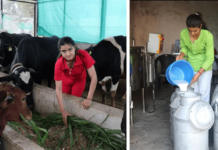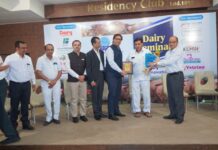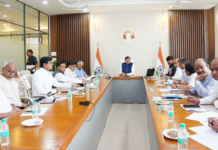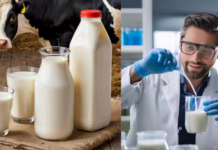New Delhi, September 25, 2024: Doubting Thomases have been proved wrong. Dark prophesies have been belied. Dr Verghese Kurien’s ambitious dream of a white revolution has come true. Known as Operation Flood, the National Dairy Development Board now has 18 dairies, in various stages of construction, being built in 10 states. It involves organizing two million farming families, to feed four metropolitan cities with a total population of over 25 million. The consumption in these cities, before the commissioning of Operation Flood, was around one million litres a day. The project aims at trebling the supply.
By giving impetus to the milk cooperative movement, Dr Kurien has revolutionized the lives of more than two million farmers. When Operation Flood is completed nearly 4.5 million peasants would be leading a better life. For them Kurien’s name will be synonymous with prosperity and organization. In the Kaira district of Gujarat, where the beginning was made some 15 years ago, in 1,000 villages there are 800 societies with a membership of over 230,000. Each society receives milk from 350 families. In fact, it has become the aim of every woman in that district to own a buffalo and supplement the family income. Such has been the impact of Dr Kurien’s experiment.
Dr Kurien’s involvement in the dairy organization was purely accidental. He started his career as an apprentice officer in TISCO. Jamshedpur. But his situation became invidious as his uncle was the managing director and a few quick promotions not only became a source of embarrassment but also hastened his resignation. Subsequently he applied, and was selected, for a government scholarship for studying dairy engineering at Michigan State University, in the United States of America, in 1948.
On his return three years later, his uncle, Sir John Mathai, had become India’s Finance Minister in Nehru’s cabinet. Dr Kurien received a lucrative job offer from an American firm, but his bond to serve the government stood in his way. He approached his relative for the cancellation of the bond. The request was spurned. Disappointed, he went away to Anand in Gujarat, on the government assignment at a paltry salary of Rs 275 a month.
Anand at that time was a conservative village, hostile to strangers. Dr Kurien recalled: “I could not get a house because I was a Christian, a bachelor and a meat-eater. I lived in his factory garage which had an improvised bathroom and no proper ventilation. In the beginning I felt miserable. From time to time I would save up some money, go to Bombay and spend a glorious weekend there. But slowly I started liking that place and its people.” He managed to get the plant rolling within a year.
At the time the AMUL plant next door was running into a lot of problems. Every time it broke down, the Chairman would turn to Kurien for help. He bought for them a modern pasteurizer for Rs 40,000 to replace their World War I’s vintage plant. Highly pleased, the Chairman offered Kurien a better salary. Kurien accepted, resigned his government job, and has been there ever since.
Twenty eight years after, today, the scene has greatly changed. From the small plant processing 250 litres of milk a day, AMUL has become a giant organization handling over 850,000 litres of milk a day, giving indirect employment to nearly 215,000 farmers, most of them do not own more than two buffaloes.
The 60-acre AMUL complex at Anand has provided the nucleus for the dairy industry in India, though it was originally organized to provide marketing facilities for the milk producers in the district only. Any farmer who owned one or more buffaloes could join the union by paying a nominal fee of Rs 10 and thus ensure his milk sale. AMUL grew in size with the passing of time and the milk supply steadily increased. But with the steady growth of the union, teething troubles set in.
Buffaloes yielded two and a half times more milk in winter than in summer. The buyers did not have the capacity to cope with the extra supply. To overcome the difficulties a Rs 50 lakh plant was set up in 1951 to manufacture butter and milk powder. This was made possible by the financial assistance of UNICEF and New Zealand. The technical aid was provided by the United Nation’s Food and Agricultural Organization.
Twice a day a convoy of 80 trucks collects milk from village society cooperatives in Kaira district and brings it to the dairy. Each society maintains a milk collection centre and a staff to receive the milk and keep accounts. A sample of the milk collected first immediately tested for its fat content. The rate of payment is on the basis of the milk quality, thus ruling out chances of adulteration. At the dairy the milk is graded once again. About four per cent of it generally turns sour. This is separately processed to produce ghee and casein—a milk protien used in adhesives and in pharmaceuticals.
Parallel to the programme of improving stock is the animal health scheme. The dairy has 21 mobile health units, 42 veterinary surgeons and special medical units standing by for emergency. The vets, according to Dr Kurien, perform more caesarian operations in a day than the government-run dairy vets undertake in their whole career. Nutritious cattle feed is also provided to the farmers at a no-profit-no-loss basis.
“Gifts can be very dangerous,” said Kurien, “they make a country dependent on foreign aid. We have been very conscious of the fact that aid can scuttle dairy development in India.”
Operation Flood is being financed entirely out of the money which the cooperative earned by selling 126,000 tonnes of skimmed milk powder and 42,000 tonnes of butter-oil. This was initially a gift from the World Food Programme.
The Board was to render technical service to the development of dairy and allied projects, provide milk procurement services, selection and purchase of equipment, give consultancy services, keep a liaison with national and international dairy boards and undertake research in animal husbandry.
The gigantic operation now aims at increasing the capacities of city milk plants and setting up of new ones. Rural feeder plants will be constructed for supplementing supply of city milk units for manufacturing milk powder, butter and ghee in times of excess milk production. The project also aims at developing an infrastructure like transportation and storage facilities for balancing the supply and demand of milk and for organizing the milk procuring system on a producers cooperative pattern.
It also involves the raising of standards in dairy farming by an improved plan in animal breeding, veterinary services, cattle feed supplies and extension services. The scheme will also endeavour to change the raw milk market from the urban areas to rural areas by removing the milch cattle population from the cities to the villages.
The agreement with the U.N. World Food Programme was signed in March 1970. However, in the first two years the quality of products supplied was substandard and was rejected by the NDDB. Besides the countries from which the WFP received its supplies were facing milk shortages. This delayed the project, giving way to a good amount of criticism from quarters which never wanted Operation Flood to succeed at all.
“I believe no one understood Operation Flood,” said Kurien. “No one wanted it to succeed. No one thought it would succeed because it was the most massive dairy experiment in the world. It was also the largest agricultural project ever attempted. When I conceived the scheme I was advised not to think so big. I said no. We had to dare, we had to do things in the manner that would have an impact in a country as big as India.”
Dare he did, and brought results, even if delayed. The mother dairy in Delhi was successfully commissioned in December 1974. It has a capacity to process and market 400,000 litres daily of pasteurized and homogenized milk through bulk vending units. The total cost of constructing and erecting the dairy was rupees three crores. Of this, the imported equipment represented an expenditure of Rs 80 lakh. The bulk vending units are an improvement over the conventional system of bottling milk. Wherever these units have been set up the milk shortage has disappeared. People no more have to get up in the early hours of the day and stand in serpentine queues to get their rationed quota of bottled milk.
However, many state governments have shunned the system and put difficulties in the way of Operation Flood. In Bombay, for instance, “efforts” are being made for the last two years to find a place to set up two bulk vending units (each unit not taking more than 100 square feet of land.) The thinking seems to be that if these units succeed many people in the allied milk industries will be affected. Those manufacturing lakhs of glass bottles every year and those making foil cover caps will be out of business. “We have to decide our priorities—whether we want a handful of people to flourish and suffer milk privations or have an assured milk supply throughout the year,” said Dr Kurien.
Besides providing adequate milk supplies, the project will have a great impact on rural employment. “If 2,000,000 people are to be given jobs in offices and factories,” emphasized Kurien, “India would need to invest Rs 2,000 crore.”
The project also has far-reaching social overtones. For instance, peasant women are brought to the AMUL plant from time to time and shown the working of the plant. “Their thirst for knowledge has to be seen to be believed,” said Kurien. “We take them around to the cattle feed plant and show them how the feed is balanced and processed. We explain to them the need to give food to a female buffalo even though she is dry. We tell them that this is the most delicate period for the buffalo because she is pregnant. We show the women how semen is collected and explain to them the mysteries of conception and birth.”
By exposing them to modernity, Operation Flood is fulfilling a great social task—it is improving the lives of India’s rural population by providing them a meaningful occupation and giving them a chance to break away from the shackles of poverty and drudgery. “Are we only discussing animals? Can the women not relate it to themselves and their children? Are we not leading them to birth control? Are we not dragging 4.5 million backward families into the twentieth century?” he asked.
NDDB is now planning Operation Flood II. This time the finances will come from the Plan funds. It has been asked to provide consultancy for three World Bank projects in Madhya Pradesh, Rajasthan and Karnataka. In all likelihood it will also be consultant to World Bank projects in neighboring countries such as Burma, Bhutan and Nepal for similar dairy projects according to the reports published in indiatoday.in.
Kurien has set his personal aims high. His aim is to ameliorate the conditions of the rural poor, rid them of their prejudices and make each village into a self-sufficient unit. For achieving this goal he has given them a magic word—cooperation. After the successful milk experiment he now wants to diversify NDDB’s activities. “Efforts should be made to set up modern rice, groundnut and sugar mills on the cooperative sector. That is the only key to solving the many economic and social ills afflicting the country. That is the only way to uplift farmers. I am convinced that the farmer does not get a just share of the consumer’s rupee; and till the time he is exploited my fight shall continue.”
For his personal achievements, he has already received his just share of recognition and medals. He was bestowed with the Ramon Magsaysay award for community leadership in 1963. He received the Padma Shri in 1965 and the Padma Bhusan in 1966; he was awarded the NIF Escort’s Man of the Year award in 1975. He has been given an honorary degree of Doctor of Sciences by the Michigan State University and an honorary Degree of Law by the University of Glasgow in 1974. In India he heads over 15 organizations in an honorary capacity. What more could a milkman working in an insignificant, poverty-ridden village ask for?

































